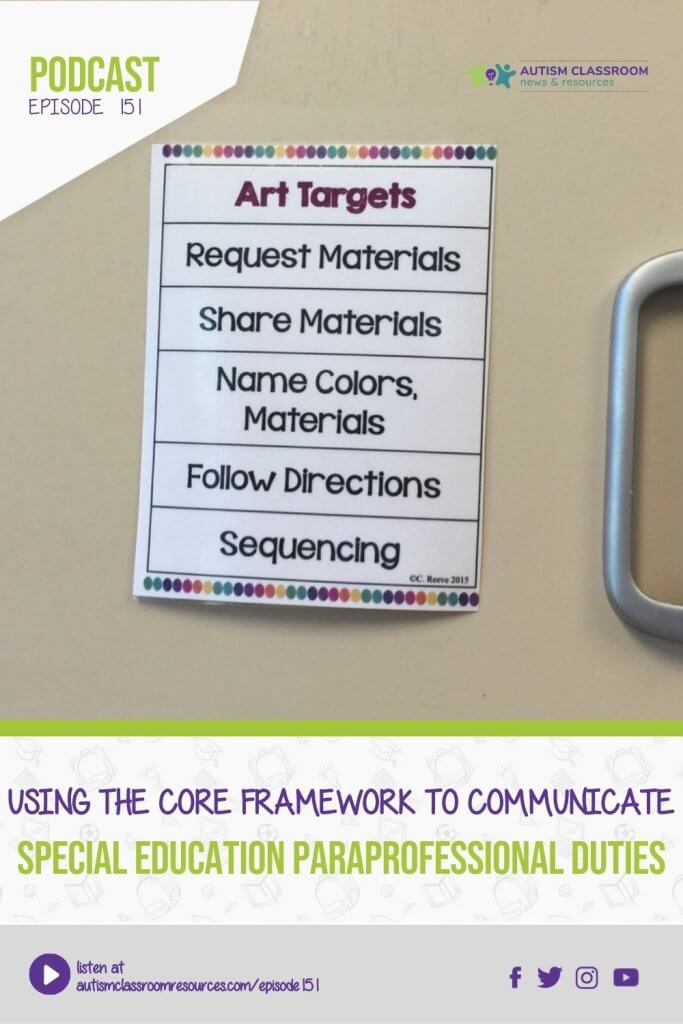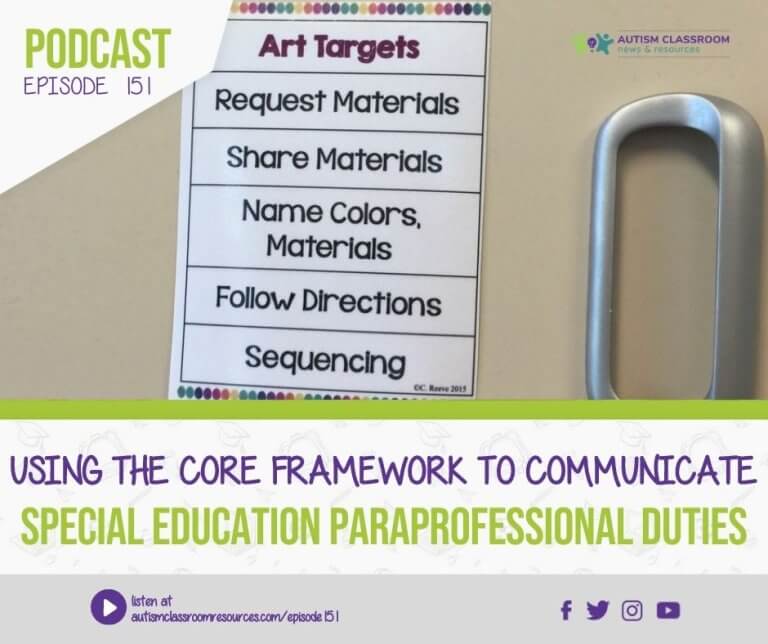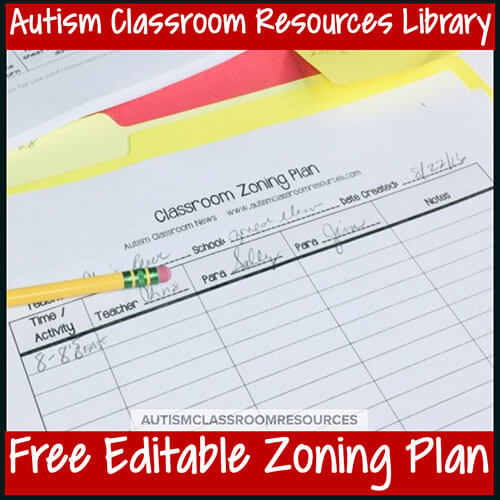Welcome to the Autism Classroom Resources Podcast, the podcast for special educators who are looking for personal and professional development.
Christine Reeve: I’m your host, Dr. Christine Reeve. For more than 20 years, I’ve worn lots of hats in special education but my real love is helping special educators like you. This podcast will give you tips and ways to implement research-based practices in a practical way in your classroom to make your job easier and more effective.
Welcome back to the Autism Classroom Resources Podcast. I’m Chris Reeve, I’m very excited that you joined us.
If you’ve been listening in the last few weeks, I have been focused on the CORE framework and the CORE stands for Classroom Organization Results in Effectiveness.
And essentially, it is all about beefing up the core of your classroom, the structure, the routine, the underlying things that make everything work. It is a framework that helps you to organize your classroom with specific systems so that it runs efficiently and so that you can get back to doing what you became an educator for, which is, of course, working with the students.
And the key component of getting all of this working is getting your staff on board and getting them working without you having to provide constant feedback, input direction, or redirection.
Now we have tons of challenges in the special ed classroom. And managing the adults is sometimes a bigger challenge than managing our students. We know that’s true. And while systems won’t change every problem situation that you might have with staff in the classroom, the systems will make your classroom run more smoothly and effectively and with less support from you.
So today, I’m going to talk about the systems that you need to help communicate the duties of paraprofessionals or aides in your classroom, and why those systems are so important and how they benefit you. So why are they worth putting the time in upfront?
For those of you who have listened to read the blog for any kind of time, you’ve heard me talk about zoning plans, and I will talk some about zoning plans today and how they fit in as a key element to this. But in addition, I’m also going to share some tools and strategies to implement in the classroom so that it runs itself more automatically when you aren’t even there, like you know when you go to an IEP meeting. So there are definitely new elements that I’m going to talk about in this episode.
Now, all this past month, I’ve been talking about the CORE framework and how it can help you. And if you’re looking for the how to implement the CORE in your classroom to make your life easier, more efficient, and let you spend more time on teaching, then come join us in the Special Educator Academy and get the how behind the framework.
We have a whole course on the elements of setting up your classroom that includes systems and strategies that I’m talking about in a lot of these episodes, including today’s and we have quick win videos and strategies beyond those that can help you make it work. And we’ve got them all gathered in one place so that you can just follow the path.
We even have two communities where you can get help with the hurdles that you’re facing in your classroom with other educators who work in classrooms like yours. So go to specialeducatoracademy.com and grab your seven day free trial to find out if SEA can help you reduce stress and help your classroom run more efficiently and effectively.
Now, let’s get started. So the first thing that you want to do as part of the CORE in working with staff in the classroom, is making sure that your staff know the needs of the students.
It’s really critical that the decisions and the things that we do in the classroom are based on the individual needs of all the students who make up that classroom. And in order to do that, it’s important that our staff know all of that as well.
Now I find it easiest to share the Teaching Implementation Plan as a good way to share the IEP. I like to do it that way because it shows them what the IEP goals are, but it also shows them mapped across the activities of the day, and the teaching strategies, and the data collection.
So if you’re sharing the TIP, and I will make sure there is a link in the show notes on what that is and how to use it, it essentially is taking the IEP and and building it across the day. So it’s how we implemented the IEP.
And I think it’s a useful tool for special educator aides and paraprofessionals because just giving them the IEP has a bunch of legalese to start with that they don’t have to worry about. But it also just tells you what the students goals are. It doesn’t necessarily tell you how we’re going to teach them or implement them. So I think that’s a key piece.
You’ll also want to share the present levels of performance from the IEP as well so they have some background information about the students. And this is really important, because legally, we need to do this, so that they can implement the IEP in the same way that we are.
Similarly, you want to make sure that you are sharing any behavior plans and supports that you have in place, and that you have written procedures for things like your classroom management system, and I’ll be talking about that in another episode.
So the next thing that you want to do is the zoning plan that I referenced at the very beginning of this episode. So a zoning plan is essentially, a little bit beyond just a schedule for the paraprofessionals. A schedule would be you’re going to be in this activity with these people. The zoning plan goes into much more detail. Now. It’s not a lesson plan so it doesn’t say teach this this way.
But what it does do is it says, who are you responsible for making sure they’re checking their schedules? How are you transitioning between your activities? Who is in charge of the walkie talkie? Who’s delivering attendance? Who is setting up the classroom job board before we get there? Who is cleaning up the snack table, so we can have art there after the next activity, and all those kinds of tasks.
So it’s essentially breaking down all the tasks that need to be done in your classroom, and making sure they get assigned to someone. We need one, because we want to make sure that everybody, all students in the classroom are getting supervised and getting taught. We want to make sure that we haven’t missed anyone in our scheduling. We want to know that our staff knows what they are expected to do.
Now, every great leader will tell you that making sure that staff knows what you expect them to do is critical to any type of management system. And as a special ed teacher or related paraprofessional or anyone who is in that kind of role, you are in charge of making sure that the staff has the information they need to do their jobs.
And I think it’s important to point out a couple of things. One is staff can’t read your mind. There’s a lot of information in that head of yours that you take as common knowledge, because you’ve done it that way for so long. You’ve known it for so long, but the staff in your classroom doesn’t necessarily know what that is. So it’s really important to put what you know, out in the open where they can access it. They can’t know what is expected of you, unless you tell them. They don’t know how you plan to implement something in the classroom unless you give them your input.
But you don’t have time to tell them at every transition, where to go, what to do, what things need to be done in the classroom. That’s where the zoning plan comes in.
It makes sure that activities are set up and cleaned up efficiently without everyone concentrating on just one of those jobs. So no more having four people cleaning the table and only one person trying to run a group with the whole class. And it helps to make sure that everything in your classroom does get done. Now it takes some tweaking when you put it in place. You try it out, you find what’s missing, you add those things in, and over time you get a zoning plan that will actually work.
And I’ve got tons of blog posts and some podcasts about zoning plans. And I’ll make sure that those are linked in the show notes at utismclassroomresources.com/episode 151.
Our next system is lesson planning. And I know that lesson planning is challenging in special education classrooms, and somewhat often shoved to the side because we have so many other things to do.
Many people often think of lesson planning is just paperwork that’s required maybe for an administrator. So should an administrator doesn’t necessarily require it, maybe we don’t do one.
And I’ve done informal polls among a number of special educators and many of them said, I have a schedule, I don’t need a lesson plan. Or I have a zoning plan, I don’t need a lesson plan. Or I have a teaching plan, I don’t need a lesson plan.
But none of those are actually lesson plans. The TIP is something that lasts all year. The schedule is just what we’re doing, the activities we’re going to during the day, but it doesn’t say what we’re going to do in those activities.
So a lesson plan is really about what we were doing this week, or I guess you could do them daily, I wouldn’t, or monthly which I think would be really hard to do. Weekly is kind of our typical kind of thing.
So why do we need lesson plans? Well, lesson plans communicate what needs to happen during instruction, zoning plans are more constant and follow the routine of the classroom. So those things are ones that are going to stay pretty steady once you get them set up unless you change the schedule. Lesson plans, what tell the staff what they need to do in those activities.
Lesson plans don’t have to be a giant time suck in order to be effective. And in fact, many times of the day, we’re focusing on the same goals and procedures, and those can stay constant, so you don’t have to change them out every week.
But having a lesson plan lets the staff know what you want them to do in an activity, rather than just be in the activity. They can be detailed, they can be brief, but they need to include directions of what you want them to do. And I have some free downloadable templates that you can grab in the Free Resource Library that I’ll link in the show notes. In addition, you can come to the Special Educator Academy where we have a whole course on lesson planning and we’re actually developing tools to make lesson planning more efficient.
So our next tool are to use checklists. Now checklists are a really great way to communicate the steps of routine tasks. They assure that staff is doing the things the way that you want them done. It makes sure that they’re completing things that you’ve asked them to do. And it helps them to know how to complete the task correctly.
So checklist can be a really useful tool for common routines and lessons in your classroom, to make sure that they’re filling out a home note correctly or giving you information every day. If they have a checklist, it’s something to remind them of what you want them to do.
And finally, the last tool is to use visuals for staff. We use visuals for our students all the time. But in reality, we all use visual supports, we just call them notes. So this part really focuses on getting what’s in your head as a teacher out in the open so others know what you want.
Now, this might include posting reminders around the room about things that are often forgotten. You know, I often have to post a note on the door, this is don’t forget the walkie talkie when the classroom leaves. I often will post target skills for different activities as a reminder that, don’t open his backpack because you’re working on his independence with that skill.
And I have a freebie for you on teaching on those kinds of target skills in the shownotes. And I also have a wide variety of adult visual supports in my TPT store so I’ll put that link in there as well.
It could also be writing down on the interactive whiteboard or somewhere else, some of the things that you do when things go wrong.
So for instance, what do you do when there’s a crisis, or when there’s a waiting period. You probably have a list of go to activities in your head that you pull out to keep your students busy when they’re waiting to go into music, or they’re waiting for something to happen on the playground before they can join, or they’re waiting for something to happen, because you’re dealing with a crisis.
My suggestion is to take that list out of your head and write it up on your board. Because then when you are encountering that situation, you can model grabbing something off that list. Hey guys, music teachers out today. So while we regroup and figure out what we’re going to do, let’s have the students all do some independent work systems from the work systems task boxes, or let’s play a quick game of I Spy from our from our list while I get this next activity set up.
So it’s an opportunity for you to say, “Hey, I’m grabbing something off of this list as a way to fill in the time when we have that unexpected burp in our schedule.” And that is a really good model for your staff to see so that they recognize that this is what you’re doing. It’s not some magic that you wield. It is a strategy that you’re using and they know what those time fillers might be that are good for your classroom, because you’ve posted them in the room.
So you’ve modeled that in hopes that when you go to an IEP meeting, and something happens and they finish something early and they have some downtime, that is the strategy that they’ll use instead of just saying, well, everybody can just kind of hang out until then, which typically doesn’t work very well in our classrooms.
It also means that the staff know when they faced that same situation, what they should do. So it’s knowing what they can do, but also knowing kind of what the expectation is that you want them to do.
Now, clearly, for many of the activities, our staff needs to be trained to implement the procedures and the specific teaching strategies. So all of this is telling them what you expected them, but it doesn’t train them to do it.
Next week, I actually will be talking about some ways to train staff, even when you don’t really have any time to talk with them when there are no students there, which I know is the case for many of you.
Now, be sure to go and grab your free downloads from the Free Resource Library. Grab the links in the show notes, and you can find all of that at autismclassroomresources.com/episode 151.
Thank you so much for joining me. I hope you have an amazing week. And I hope to see you back here again next week. Bye guys.











